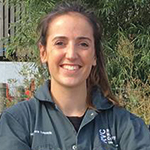How to get the best from your vet student at lambing
 © Tim Scrivener
© Tim Scrivener Lambing placements offer a window into the sheep industry, and should be seen by farmers as a good investment, says vet Emily Gascoigne of Synergy Farm Health.
They might even inspire a student to be a sheep specialist. “A lambing placement is a very formative place,” she says.
“It offers a real breadth of genuine hands-on experience in nutritional, obstetric and medicine management – and it’s also of potential help to sheep farmers.”
So, how can you get the best from your vet students, and make sure lambing time is a valuable experience for them?
We asked farmers that use vet students for their top tips and spoke to students and a vet for their advice.
See also: 8 ways to prepare for a busy lambing season
The panel

Kevin Harrison farms at North Stoke, between Bath and Bristol. He has 900 North Country Mules, including 150 ewe lamb replacements. Lambing is indoors and lasts for three weeks. For the past 30 years between one and four vet students have helped him at lambing time.
 Sam Jones farms in Redditch, Worcestershire. He runs 1,050 North Country Mules, put to a Texel, and 150 Texel crosses, mated to a Charollais. Lambing is 90% indoors. He has welcomed students for the past 20 years, with two lots of four students each doing 10 days in the lambing shed.
Sam Jones farms in Redditch, Worcestershire. He runs 1,050 North Country Mules, put to a Texel, and 150 Texel crosses, mated to a Charollais. Lambing is 90% indoors. He has welcomed students for the past 20 years, with two lots of four students each doing 10 days in the lambing shed.
 Emily Gascoigne is a vet with Dorset-based Synergy Farm Health. A recognised sheep specialist, she is particularly interested in flock health planning and reducing production losses on sheep units. She heads sheep farmer training – including lambing and lamb post-mortem courses – for the practice and is also involved in vet student training.
Emily Gascoigne is a vet with Dorset-based Synergy Farm Health. A recognised sheep specialist, she is particularly interested in flock health planning and reducing production losses on sheep units. She heads sheep farmer training – including lambing and lamb post-mortem courses – for the practice and is also involved in vet student training.
 Annabelle Loustric first studied Bioveterinary Sciences at London’s Royal Veterinary College before starting her training, and is due to graduate in 2022. Her lambing placements at Kevin Harrison’s farm in 2019 and 2020 “made her really appreciate the hard work farmers do ensure the food we eat is safe and of the highest quality”.
Annabelle Loustric first studied Bioveterinary Sciences at London’s Royal Veterinary College before starting her training, and is due to graduate in 2022. Her lambing placements at Kevin Harrison’s farm in 2019 and 2020 “made her really appreciate the hard work farmers do ensure the food we eat is safe and of the highest quality”.
 Cara MacGregor is a third-year vet student at the University of Edinburgh. She spent her lambing placement at Sam Jones’s farm in 2019 and returned last year. “I definitely struck gold,” she says. “Sam was so willing to share his knowledge, it was incredible.”
Cara MacGregor is a third-year vet student at the University of Edinburgh. She spent her lambing placement at Sam Jones’s farm in 2019 and returned last year. “I definitely struck gold,” she says. “Sam was so willing to share his knowledge, it was incredible.”
1. Plan to get off to the right start
- Ask as many questions as possible in advance. Do they have a lot of experience, some, or none? Are they meat-eaters, vegetarian or vegan? You don’t want any surprises when you’re tired.
- Try to use people recommended by past students.
- Explain that lambing time is full-on, with a lot of pressure on everyone.
- Don’t just chuck your students in a caravan, point them to the local shop and let them get on with it. Offer full accommodation, if possible.
- Remember not all students have cars. In this instance, should you be prepared to insure them on a farm vehicle?
- Be realistic about their capabilities: most students will have little or no experience. Rather than a disadvantage, think of it as a blank canvas, and approach the placement with an open mind.
- Farmers who really invest time in mentorship and training at the start of the placement get the most from their students.
2. Organise rotas
- Invest time in your first students and overlap placements so they can pass on their experience to the next ones.
- Overlap daily shifts so information can be shared.
- Some farmers keep students for daytime responsibilities, while others see night-time as a great opportunity for them to do nursery tasks like tagging, castrating and tailing. Either way, it’s best to have too many rather than too few.
- Work them in pairs, especially when it’s busy or if they are expected to do night duty.
Typical rota
- 4am-1pm: Morning shift
- 8am-6pm: Day shift – mainly students who live close by
- 4pm-1am: Evening shift
- 12am-9am: Night shift – students with experience
- 6am-12am: Farmer’s shift – so there is always someone to call if there is a problem
- Shifts overlap to allow for handovers
3. What to ask students to do
- Don’t ask them to do anything you wouldn’t want to do yourself.
- Don’t push them too hard even if they do have experience. They will still have to learn how you do things on your farm.
- Build them up to take on more responsibility and they will be the gift that keeps on giving.
- Remember health and safety. Don’t expect students to drive quad bikes without the appropriate training and safety equipment.
4. How to manage multiple staff
- Get to know which students are good at what and let them find the best way to share the workload.
- As a rule, if you create a trusting environment where everyone knows their job, it all slots into place.
- Have a good system of communication including blackboards on sheep pens to record and pass on information.
- Use mobile radios so decisions can be made quickly without trying to get a phone signal. Always be at the end of a radio so you can hear what’s going on.
5. Using protocols and which areas to focus on
Set out standard protocols, especially in the context of any treatment.
Focus on the following areas:
- Checking colostrum
- Checking lambs have suckled
- Dipping navels
- Replenishing water, hay and straw
- Pen cleanliness
- Ear-tagging
- Recording – for example, assistance at lambing, mothering ability (and if you use electronic identification)
- Castrating
- Numbering
- Fostering
- Bottle-feeding
- Takeout from pens.
6. Boosting morale
- Harness students’ enthusiasm: it’s really satisfying for them to go to bed feeling they’ve learned something.
- Have tea breaks together, preferably in sight of the lambing shed.
- Provide plenty of food and drink.
- Ensure students know they’ve got support when they need it.
- Consider paying them: if you wouldn’t want to work for nothing, should they?
- Ask for their ideas: little improvements can make big differences.
- Everyone makes mistakes and has to learn. Go through what went wrong, calmly.
- Give credit where it is due.
7. How to assess how lambing is going
Make time for discussion. Tea breaks can turn into team meetings where what needs to be done next can be discussed. Or keep tea breaks for quick chats and save longer chats for the evening. Either way, keep talking.
8. How to meet students’ needs
- Enable wider learning opportunities, such how to prioritise tasks, practise reliability and develop resilience – important skills for vets. For example, students learn that they can’t just give up when a lamb is stuck, but have to keep going, even if they are tired and sore. They also learn not to leave piles of jobs for the next shift to pick up.
- Be prepared to answer lots of questions. Students have to set their own goals as well as meet the learning objectives for the placement. On top of practical lambing skills, these cover a wide range of areas of sheep husbandry, for example, dosage regimes, stocking rates and lamb quality.
- For larger flocks, consider asking your vet to spend an hour with the students revising the basics.
How to find vet students
Contact your local vet school or university
- Royal Veterinary College, London
- Harper and Keele Veterinary School
- Bristol
- Cambridge
- Edinburgh
- Glasgow
- Liverpool
- Nottingham
- Surrey
Other organisations
- The Farm Animal Veterinary Society is a student-run organisation for vet students interested in farm animal medicine
- The National Sheep Association (NSA) runs a lambing list for members to advertise to vet students (and others) seeking work experience
Seek recommendations via social media
Covid update
In response to the ongoing coronavirus pandemic, the total duration of placements that first and second-year UK vet students have to do has been cut temporarily from 12 weeks to six.
The decision follows discussions between the Vet Schools Council and the Royal College of Veterinary Surgeons.
“The requirements might vary between the different vet schools,” says Annabelle Loustric.
“But my university [at least] is encouraging students to still do two weeks of lambing, because we gain so much from the placement.”
